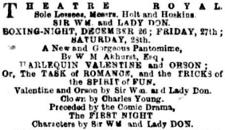 2230788924694359384.jpg
2230788924694359384.jpg
 2230788924694359384.jpg
2230788924694359384.jpg
Set in Greece, Egypt, and medieval France (but with the final tableaux showing Australian explorer Robert O'Hara Burke crowned by Fame), the pantomime begins with the King of France and his courtly train riding forth into Artois Forest on Saint Valentine's Day. While in the forest, he finds a new-born baby in the thicket and takes the child home, naming him in honour of the day upon which he was discovered. Many years later, the young knight is eager to claim his first adventure. After presenting himself at the gates of King Pippin, he forthwith falls in love with the monarch's daughter, Eglantina, and is offered her hand in marriage if he proves himself. His opportunity comes in the form of a petition from 'three palmers clad in grey', who ask that he give them assistance with a savage boy who lives in the Forest of Artois. Said to have amazing strength, the boy lives among the bears and has a taste for the blood of men. Valentine ventures forth, but is attacked by the savage first. Almost overcome and bloodied, the knight eventually wins out and tames the boy, making him into a trusting servant. Together, the pair set out to seek information about their parentage, and along the journey undertake several adventures. This includes pitting their wits against a terrible giant and saving a dame who has been held captive for twenty years. The woman turns out to be their mother, and all ends happily.
According to the Argus theatre critic, 'the quality of the writing is wretched, but the piece [was] richly mounted and superbly illustrated' (27 December 1861, p.5). The Age critic agreed, suggesting that some pruning was required:
'The introduction to the pantomime might be compressed with advantage. At present its length rendered it rather fatiguing to the audience, and it is not so lively or mirth provoking as could be wished. The appointments and scenery are, however, as we have before stated, admirable' (27 December 1861, p.5).
The music combined operatic and 'Ethiopian' (minstrel) styles.
1861: Theatre Royal, Melbourne, 26 December 1861 - 21 January 1862.
This entry has been sourced from research undertaken by Dr Clay Djubal into Australian-written popular music theatre (ca. 1850-1930). See also the Australian Variety Theatre Archive
Details have also been derived in part from the Annotated Calendar of Plays Premiered in Australia: 1850-1869.